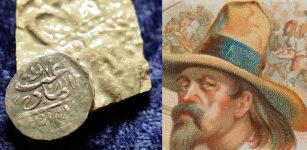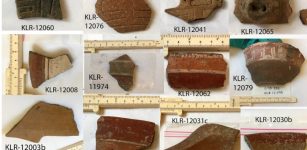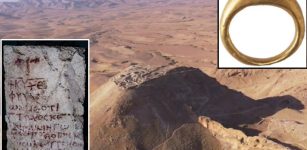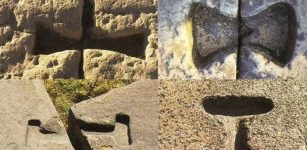King Solomon’s Magical Shamir Could Cut Through Any Stone – Proof Of Advanced Ancient Technology?
Ellen Lloyd - AncientPages.com - Did King Solomon have access to sophisticated ancient technology? What kind of device was able to cut through or disintegrate stone, iron, and diamond thousands of years ago?
King Solomon, son of King David and Bathsheba, is renowned in the Old Testament for his wisdom. He is also known for his riches, which were given to Solomon by God, along with wisdom.
According to a very interesting legend found in the Talmudic literature, King Solomon built his magnificent temple in Jerusalem with help of a magical worm named Shamir.
The Shamir was, without doubt, an extraordinary object as it possessed the ability to alter stone, iron, and diamond, by its mere gaze.
Artist's interpretation of the First Temple in Jerusalem. Credit: Public Domain
The Shamir existed already in the time of Moses who used to engrave the Hoshen (Priestly breastplate) stones that were inserted into the breastplate. When King Solomon learned about the object he commissioned a search that turned up a "grain of Shamir the size of a barley-corn.
According to the story, King Solomon learned from the demon Ashmedai that the worm had been entrusted to the care of the Prince of the Sea who has given it into the charge of the hoopoe bird (or woodcock).
Solomon's servant set out to find it, and succeeded in delivering it safely to King Solomon.
The most puzzling part of this story is that no one really knows what the Shamir was.
According to the legend, the material to be worked, whether stone, wood, or metal, was affected by being "shown to the Shamir." What does it mean? From where did this marvelous Shamir come? How was it kept?
Some scholars have suggested that the Shamir was almost like a living being. Other early sources, describe it as a green stone.
It is said that the Shamir was always wrapped in wool and stored in a container made of lead, since any other vessel would burst and disintegrate under its gaze. Based on this description, some scholars have concluded that the Shamir's true nature was radioactive, that it was in fact a small sample of a naturally occurring radioactive isotope, possibly radium.
In the Book of Kings it is written: "For the house, while it was in the building, was built of stone made ready at the quarry; and there was neither hammer nor ax nor any tool of iron heard in the house while it was being built." The midrash tells us: The stones moved of their own accord; they flew and rose up by themselves, setting themselves in the wall of the Temple and erecting it."
This sounds like ancient people mastered levitation.
However, according to another tradition, the Shamir readied the stones, so that the stones emerged hewn from the quarry, ready for placement in Solomon's Temple. Solomon remembered the biblical injunction: "....if you make me an altar of stone, you shall not build it of hewn stones; for if you lift up your tool upon it, you have polluted it." (Exodus 20:25)
Luca Giordano: The Dream of Solomon: God promises Solomon wisdom. Image credit: Luca Giordano - Web Gallery of Art: Public Domain
Unfortunately, the purpose and origin of the Shamir remain unknown. We can .only speculate what role this enigmatic object played in the construction of King Solomon's Temple.
Furthermore, the Shamir was said to have been either lost or had lost its potency by the time of the destruction of the First Temple at the hands of Nebuchadnezzar in 586 B.C.
Written by Ellen Lloyd - AncientPages.com
Copyright © MessageToEagle.com. All rights reserved. This material may not be published, broadcast, rewritten or redistributed in whole or part without the express written permission of MessageToEagle.com
More From Ancient Pages
-
 Can This Ancient Coin Solve The Mysterious Disappearance Of Pirate Henry Every?
Archaeology | Apr 1, 2021
Can This Ancient Coin Solve The Mysterious Disappearance Of Pirate Henry Every?
Archaeology | Apr 1, 2021 -
 Discovery Of Chromosomes Offers Evidence Of Ancient Humans Living In South America Over 18,000 Years Ago
Archaeology | Aug 21, 2022
Discovery Of Chromosomes Offers Evidence Of Ancient Humans Living In South America Over 18,000 Years Ago
Archaeology | Aug 21, 2022 -
 Magnificent Hattusa: Capital Of The Hittite Empire
Civilizations | Apr 11, 2021
Magnificent Hattusa: Capital Of The Hittite Empire
Civilizations | Apr 11, 2021 -
 Grandfather Frost And Snow Maiden Bring Gifts On New Year’s Eve
Christmas Traditions | Dec 31, 2024
Grandfather Frost And Snow Maiden Bring Gifts On New Year’s Eve
Christmas Traditions | Dec 31, 2024 -
 Surprising Diversity Of Ethnic Groups In The US Virgin Islands Before Columbus – New Study
Archaeology | May 18, 2023
Surprising Diversity Of Ethnic Groups In The US Virgin Islands Before Columbus – New Study
Archaeology | May 18, 2023 -
 Byzantine Greek Inscription Of Psalms 86 Found In Hyrcania
Archaeology | Sep 29, 2023
Byzantine Greek Inscription Of Psalms 86 Found In Hyrcania
Archaeology | Sep 29, 2023 -
 The Untold Story Of The Great Sphinx – Puzzling Discoveries – Part 2
Featured Stories | Aug 13, 2019
The Untold Story Of The Great Sphinx – Puzzling Discoveries – Part 2
Featured Stories | Aug 13, 2019 -
 Beautiful Temple Dedicated To Ninhursag, Goddess Of Childbirth And Divine Protector Of Wild Animals
Civilizations | Jan 3, 2017
Beautiful Temple Dedicated To Ninhursag, Goddess Of Childbirth And Divine Protector Of Wild Animals
Civilizations | Jan 3, 2017 -
 Mystery Of Ancient Metal Clamps – Advanced Lost Technology Modern Science Still Cannot Explain
Ancient Technology | Jul 31, 2020
Mystery Of Ancient Metal Clamps – Advanced Lost Technology Modern Science Still Cannot Explain
Ancient Technology | Jul 31, 2020 -
 Ravana: Ten-Headed And Multi-Armed Demon King Of Lanka And Chief Antagonist In Epic Ramayana
Featured Stories | Oct 8, 2019
Ravana: Ten-Headed And Multi-Armed Demon King Of Lanka And Chief Antagonist In Epic Ramayana
Featured Stories | Oct 8, 2019 -
 Cornucopia – ‘Horn Of Plenty’ – Ancient Symbol And Its Almost Forgotten Meaning
Ancient Symbols | Jan 14, 2019
Cornucopia – ‘Horn Of Plenty’ – Ancient Symbol And Its Almost Forgotten Meaning
Ancient Symbols | Jan 14, 2019 -
 Revealing 1,200 Years Of Arctic Canadian Cultures And Settlements In Canada
Archaeology | Jul 11, 2024
Revealing 1,200 Years Of Arctic Canadian Cultures And Settlements In Canada
Archaeology | Jul 11, 2024 -
 1,500-Year-Old Joint Burial Offers A Look Into Attitudes Toward Love And The Afterlife
Archaeology | Sep 14, 2021
1,500-Year-Old Joint Burial Offers A Look Into Attitudes Toward Love And The Afterlife
Archaeology | Sep 14, 2021 -
 How Far South Did Prehistoric Highly Skilled Polynesian Seafarers Sail?
Archaeology | Nov 1, 2024
How Far South Did Prehistoric Highly Skilled Polynesian Seafarers Sail?
Archaeology | Nov 1, 2024 -
 Archaeologists unearthed artifacts in a 3,700 year-old mine factory
Artifacts | Aug 22, 2015
Archaeologists unearthed artifacts in a 3,700 year-old mine factory
Artifacts | Aug 22, 2015 -
 Aglaonice (Aganice): Female Greek Astronomer From Thessaly Was Believed To Be A Witch
Featured Stories | Sep 4, 2019
Aglaonice (Aganice): Female Greek Astronomer From Thessaly Was Believed To Be A Witch
Featured Stories | Sep 4, 2019 -
 On This Day In History: Astronomer John Couch Adams And The Discovery Of Planet Neptune – On July 3, 1841
News | Jul 3, 2016
On This Day In History: Astronomer John Couch Adams And The Discovery Of Planet Neptune – On July 3, 1841
News | Jul 3, 2016 -
 Unexplained Accounts Of Mysterious Fires – No Traces But It Happened – Part 2
Featured Stories | Aug 6, 2019
Unexplained Accounts Of Mysterious Fires – No Traces But It Happened – Part 2
Featured Stories | Aug 6, 2019 -
 Evidence Of The 586 BCE Babylonian Destruction Of Jerusalem’s Monumental Building – Reconstructed
Archaeology | Jul 28, 2023
Evidence Of The 586 BCE Babylonian Destruction Of Jerusalem’s Monumental Building – Reconstructed
Archaeology | Jul 28, 2023 -
 Why Was The Magical Sword Azoth Of Paracelsus So Special?
Featured Stories | Dec 24, 2020
Why Was The Magical Sword Azoth Of Paracelsus So Special?
Featured Stories | Dec 24, 2020


